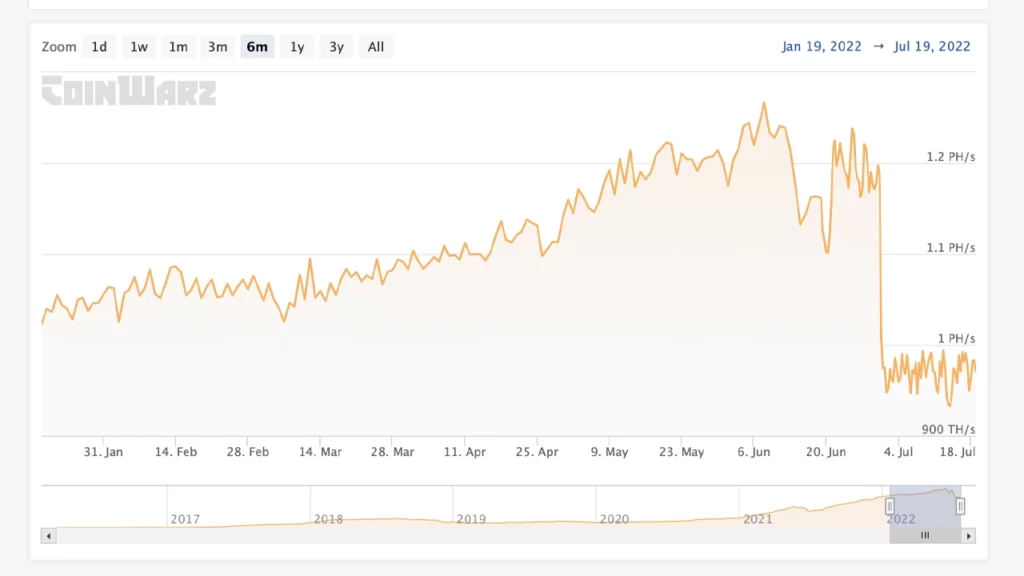
While a tentative date for The Merge has been pencilled in by developers, and even though it’s quite possible it could be delayed once again, Ethereum’s hashrate has dropped 26.26% during the last 45 days. 18.21% of the hashrate loss took place after June 30, as Ethereum’s global hashrate slipped from 1,190 terahash per second (TH/s) to today’s 973.27 TH/s. While Ethereum’s hashrate decreased, Ethereum Classic’s hashrate spiked 12.07% higher during the last two days, but the added terahash was way less than the hashrate that left Ethereum during the last few weeks.
Ethereum hash rate and mining revenue slides, 217 TH/s lost since record high Ethereum hash rate
A few days ago, on July 16, 2022, Bitcoin.com News reported that although the timeline is not final, The Merge could be implemented on September 19, 2022. Software developer Superphiz shared a “timeline of planning” last week, which set a tentative date for Ethereum to transition from a proof-of-work (PoW) consensus model to a proof-of-stake (PoS) consensus model.
The developer stressed that the date was not finalized but he also remarked that it was “extremely exciting” to see the transition coming together. The proposed date for The Merge fueled ethereum’s (ETH) value against the U.S. dollar, but it also increased ether gas fees by a dollar or more per transfer, at a time when transaction fees have been low.
Interestingly, the ETH hashrate has also gone down, just as the apparent date for The Merge was set by ETH developers last week. Overall, Ethereum’s computing power began to decline 44 days ago, after hitting an all-time high (ATH) at 1,320 TH/s or 1.32 petahash per second (PH/s) on June 4, at a block height of 14,902,285.

Since then, ETH’s global hashrate has been reduced by 26.26%, but the biggest drop during the last six months occurred on June 30. Ethereum’s hashrate dropped 18.21% from 1,190 TH/s to the 973 TH/s range, or under the 1 PH/s range. When Ethereum finally transitions from PoW to PoS, PoW miners will have to dedicate Ethash hashpower elsewhere or stop mining.
It is assumed that a majority of ETH PoW miners will simply mine Ethereum Classic (ETC), as both networks share the same Ethash algorithm. One would assume that the recent 12.07% increase in ETC hashrate comes from ETH miners, however, while ETH lost 217 TH/s, ETC only gained 2.11 TH/s .
It’s arguably easier to assume that 217 TH/s shut off over the lack of profits from ETH’s fiat value dropping last month. Ethereum miners are not making the profits they once did months ago. On May 7, 2021, ETH miners made $93.16 million in 24 hours, and on January 5, 2022, ETH miners raked in $85.38 million in a 24-hour period. Today, more than half of that revenue is gone and during the last 24 hours, miners made $43.23 million.
Ethash is still the most profitable consensus algorithm today, as the new Bitmain Antminer E9 with 2.4 gigahash per second can generate an estimated profit of $56.49 per day. Compare that to one of today’s most profitable bitcoin miners, the Bitmain Antminer S19 XP with 140 TH/s, which makes $5.17 per day in profit.
Statistics show that there are 78 listed mining pools that mine ETH today and Ethermine.org is the largest miner in terms of hashrate. Ethermine.org commands 260.20 TH/s of today’s 973 TH/s. The 712.8 TH/s left stems from the dozens of ETH pools that mine ether every day.


















